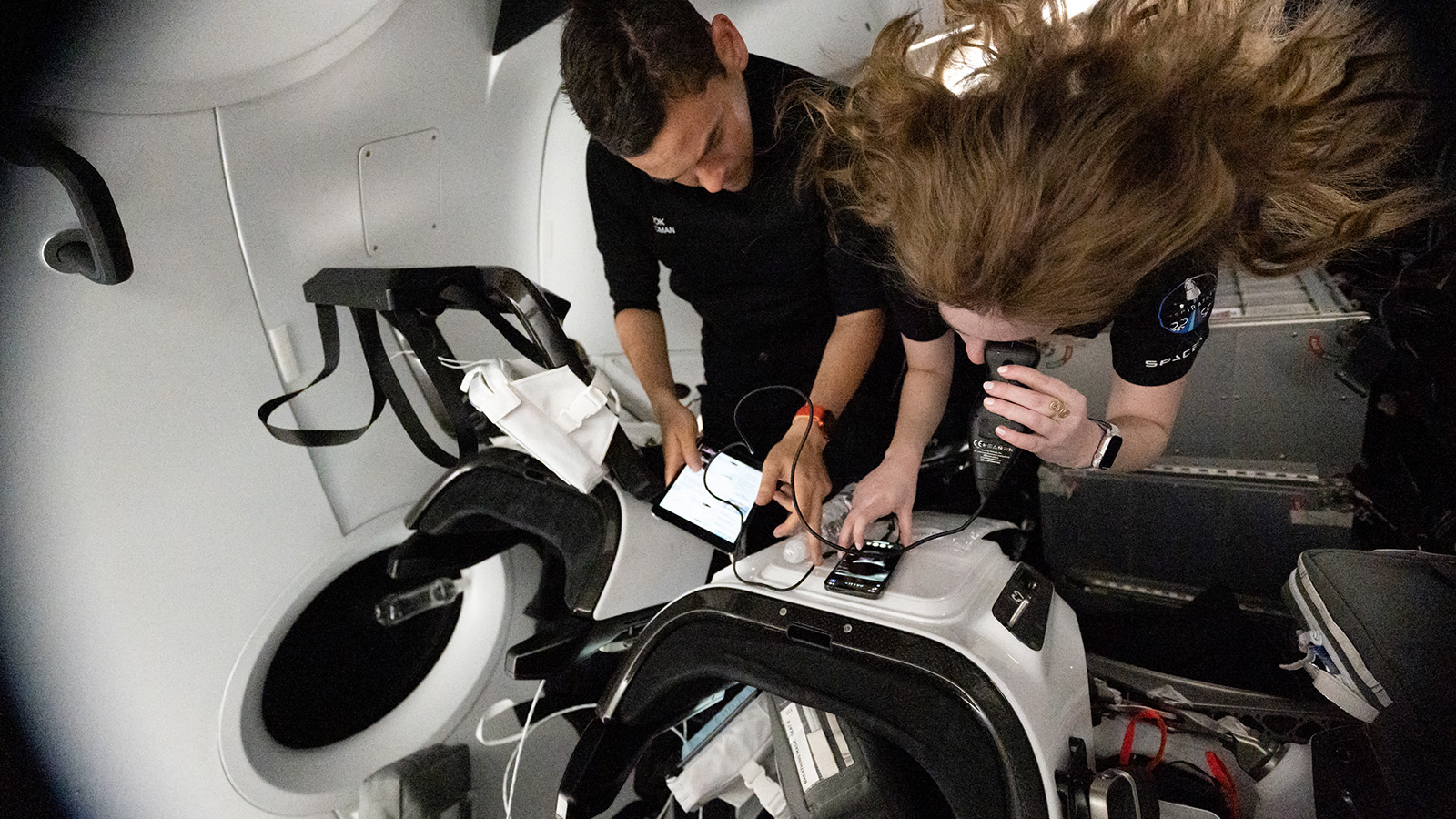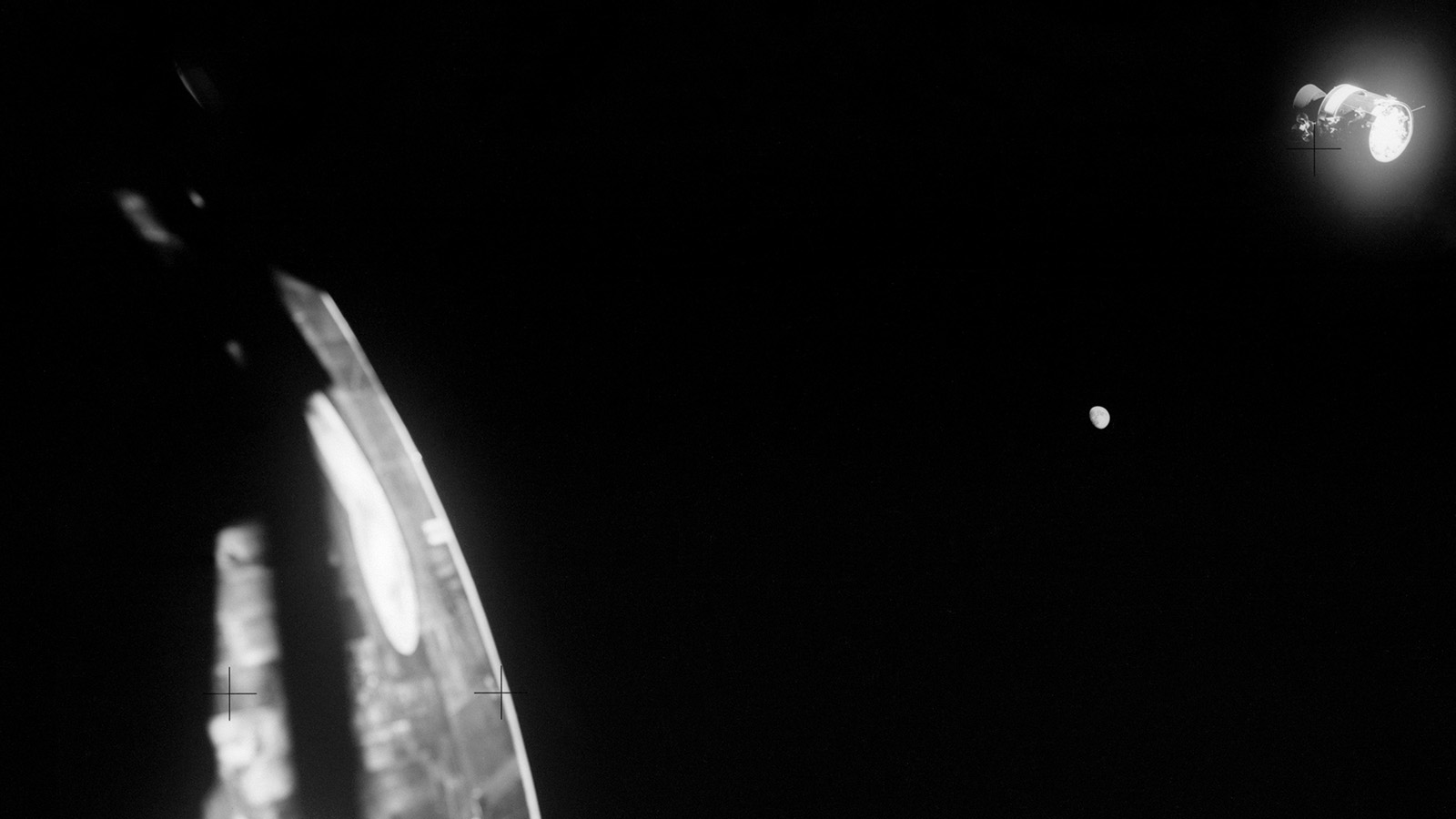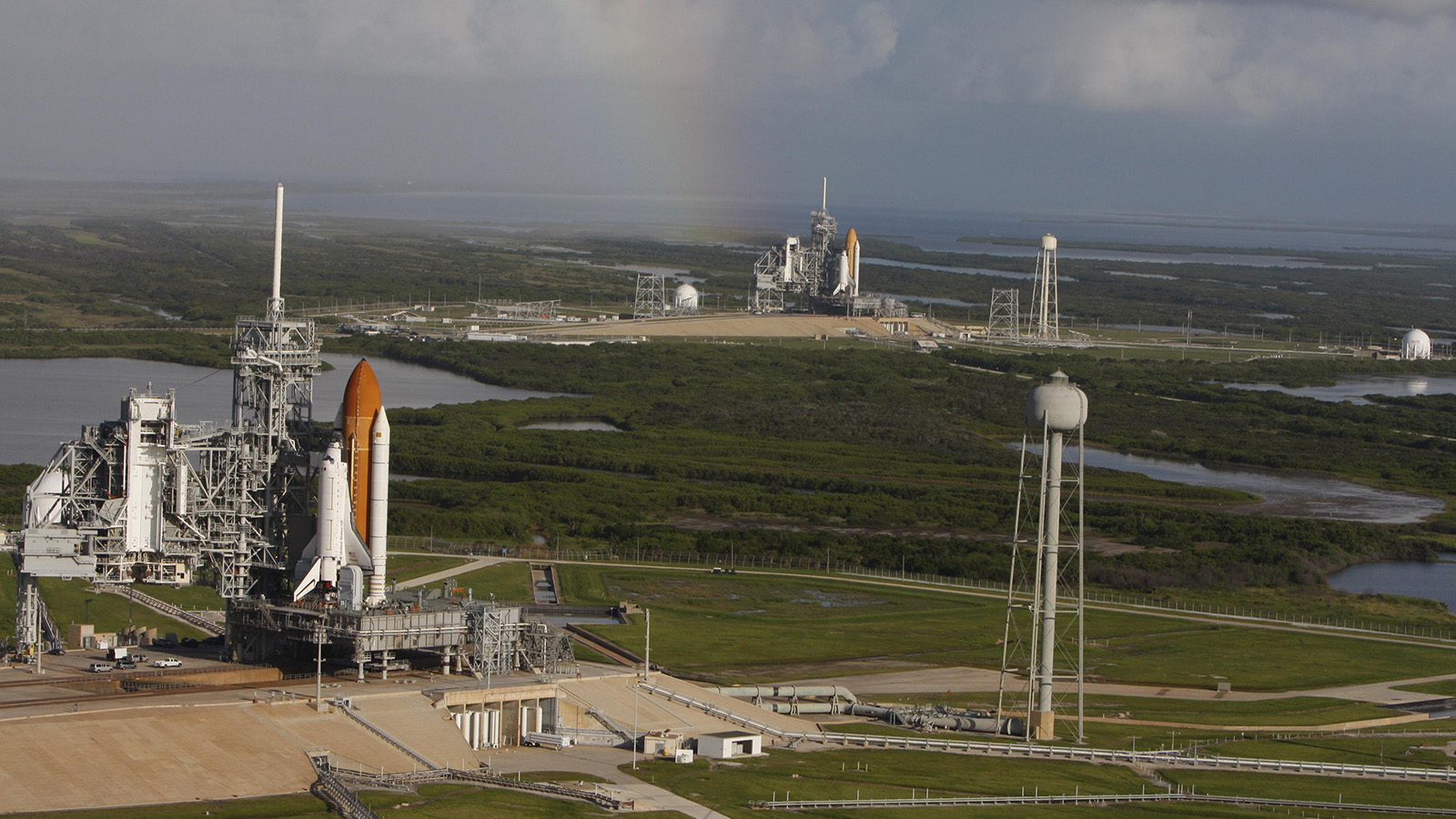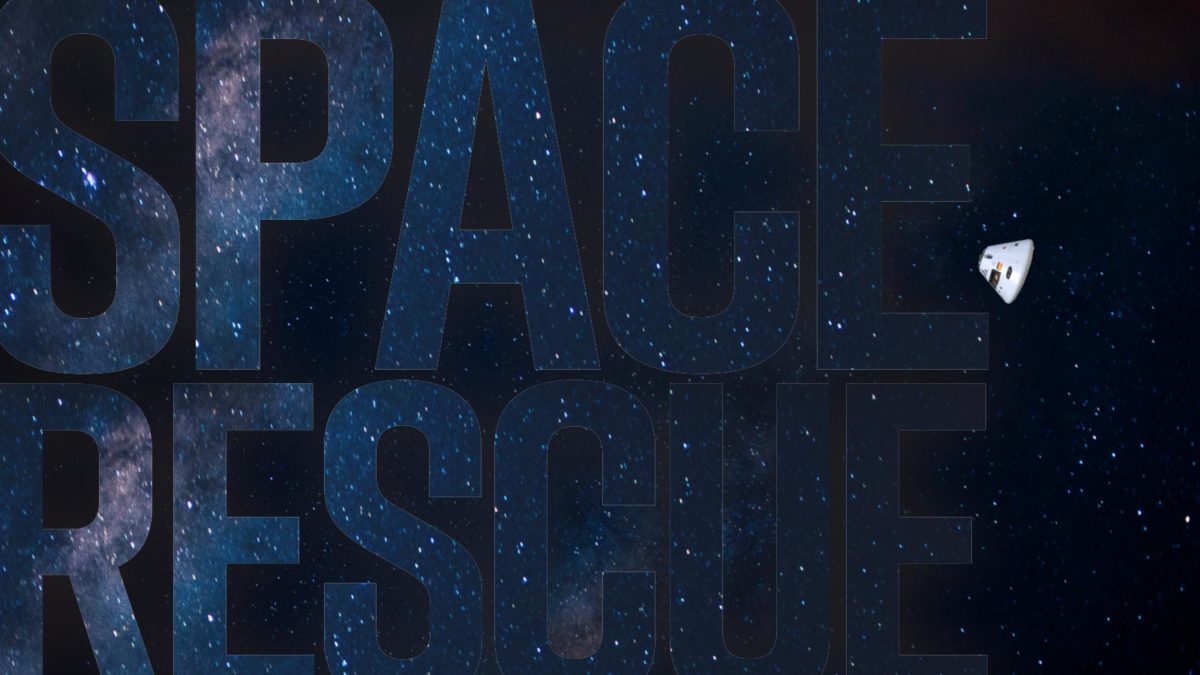Space rescue: The lessons from history that could save lives
By Paul Marks|November 2021
The fact that more civilians are going to space has sparked a realization by at least one spaceflight analyst that something may be missing: A way to rescue astronauts or spaceflight participants in disabled spacecraft.
★ Click at right to open this story’s Knowledge Guide entries.
★ Click star at right to open Knowledge Guide.
Grant Cates’ wife confronted him with what seemed like an obvious question last February when he told her he had entered the lottery for a seat on Inspiration4, the first all-civilian orbital space mission: How could he be rescued if something went wrong?
“I said the worst-case scenario is that something goes wrong and I float around the Earth for a couple of weeks and the air goes bad. But I would get to say goodbye.” Unimpressed, his wife said to him that he’d “better figure out a way” to rescue himself, Cates says.
All this turned out be moot. The anonymous winner of the St. Jude sweepstakes gifted the coveted seat to Lockheed Martin engineer Chris Sembroski, who splashed down in SpaceX’s Crew Dragon Resilience spacecraft in September with three fellow space enthusiasts.
The experience, however, set Cates’ mind in motion: The senior engineering specialist at the Aerospace Corp.’s space architecture department in Chantilly, Virginia, followed his wife’s advice and researched all the current in-space rescue capabilities available in the United States — under the auspices of the federally funded corporation’s latest offshoot, the Space Safety Institute, which it has established to provide independent safety advice to spaceflight organizations based in the U.S.
What Cates — a former NASA space shuttle ground crew chief — found is surprising, especially given that, if one listens to the growing clamor from space enthusiasts, humanity is at the dawn of a massive outward expansion into the final frontier.
“The U.S. government and commercial spaceflight providers have no plans in place to conduct a timely rescue of a crew from a distressed spacecraft in low- Earth orbit, or anywhere else in space,” Cates writes in his analysis, which was published in the September edition of the Journal of Space Safety Engineering. He found that some of the lessons learned by NASA early in the human space program have been all but forgotten: from the way the Apollo 13 crew implemented the option to turn their lunar lander into a lifeboat to conserve fuel and electricity in their damaged command module, to the fact that standby launch vehicles and spacecraft were ready on the pad in case rescue missions were needed in both the Skylab and space shuttle programs.
“The risks involved in space travel are many, and they are magnified by the fact that there are no plans and attendant capabilities in place for the timely rescue of a crew from a disabled spacecraft,” he writes. It’s a solvable problem, he contends: The United States “as the world’s greatest spacefaring nation has the wherewithal to develop and employ effective in-space rescue capabilities.”
More people in space
Cates’ analysis comes as civilian launches are poised to increase. Up next after September’s Inspiration4 three-day jaunt will be the Axiom-1 mission to the International Space Station led by Axiom Space of Houston. Former NASA astronaut Michael López-Alegría, Axiom’s vice president of business development, will fly with three space tourists to ISS in February 2022 aboard a Crew Dragon. Axiom plans at least three similar missions and aims to build the first commercial space station, too.
Then there are the movies in the works: On Oct. 5, Soyuz MS-19 delivered a Russian film crew, comprising actor Yulia Peresild and director Klim Shipenko, to the ISS on a 12-day visit to shoot their film “The Challenge.” Late next year, actor Tom Cruise and director Doug Liman reportedly plan to shoot their own movie on the ISS. In 2023, SpaceX plans to conduct a crewed lunar flyby — the mission is called dearMoon — with its in-development Starship vehicle consisting of a Super Heavy booster and Starship crew spacecraft, while Boeing’s delayed Starliner spacecraft and Sierra Nevada’s Dream Chaser spaceplane are perhaps further options for future civilian trips to LEO and beyond. Blue Origin’s future New Glenn and New Armstrong launchers could carry crews, too.
Meanwhile, NASA under its Artemis program is planning an initial 2024 moon landing in which a Space Launch System rocket would launch an Orion spacecraft and astronauts toward lunar orbit. The crew would rendezvous directly either with Starship, if a lawsuit by losing bidder Blue Origin fails, or first with a planned lunar Gateway space station that might or might not be ready. More landings under NASA’s Artemis program would follow, while China and Russia are planning a joint base at the moon’s south pole.
Despite all this activity, Boeing, SpaceX, Blue Origin and the Inspiration4 team either did not respond or declined to discuss any rescue plans they might or might not have. SpaceX said it was “an incredibly demanding time for the team” and that they did not have anyone available to comment. Boeing initially thought the issue an “interesting angle” but later deferred questions on rescue to NASA, its customer for Starliner services. Axiom Space and Sierra Nevada did not respond to emails.
If such space operators want to be prepared with rescue contingencies for these and other missions, history shows it’s doable, says Cates. “It doesn’t need to cost a great deal and doesn’t require any new technologies that don’t already exist. They do exist. We really need to put in place rescue capabilities before we need them, before we have a crisis,” he tells me.
In cases where dispatching a rescue ship would be the only solution, there is no legal mandate for national space agencies or commercial spaceflight firms to provide any in-space rescue capability. In fact, at the urging of heavily pro-innovation groups including the Commercial Spaceflight Federation, the U.S. Congress has ensured that through at least October 2023 the FAA must only regulate space launches as far as it affects protecting the “uninvolved public,” meaning people on the ground or in aircraft. FAA does not regulate for the safety of astronauts or spaceflight participants, which means all is needed is informed consent about the risks (of hypersonic flight in a vacuum surrounded by volatile fuels and space debris).
FAA’s Office of Commercial Space Transportation, however, is aware that change could be coming. If it were to regulate for passenger safety, the office likely would not require a commercial operator to have a rescue launch vehicle and spacecraft at the ready. “I don’t foresee in the course of my career having that type of capability,” says Wayne Monteith, head of the FAA space office, in an Aerospace America Q&A. Rather, the approach might be to “regulate on what is controllable,” he says, meaning “the things that are actually on the capsule itself: how redundant your life support systems need to be, how much extra consumables do you need to have on board to have a safe margin.”
Could international regulations come into play? By its title, the Agreement on the Rescue of Astronauts, part of the United Nations’ 1967 Outer Space Treaty, sounds like the answer to a stranded astronaut’s woes. But its scope is mainly about search and rescue on the surface of Earth. “If the personnel of a spacecraft lands in the territory of a state, that state has to take all possible steps to rescue them,” says Joanne Wheeler, a space lawyer and managing partner with Alden Legal in London. “But that requirement regarding search and rescue only applies if the state is ‘in a position’ to help.” So the treaty does not order nations to develop and provide space rescue services — just help if they can.
But with what Wheeler calls the “changing dynamics” of spaceflight — with new nations, new commercial operators and space tourists entering the field — she says the issue of rescue “does need to be looked at again.” Would the rescue agreement, for instance, apply to “astronauts” and civilian “spaceflight participants” alike? “Once we establish a rescue mechanism, I doubt there will be a difference between both categories for the purposes of a rescue,” she says.
A history of rescue plans
What is clear in Cates’ analysis is that the space industry has considered contingencies before and developed rescue mechanisms, but today’s space operators show little sign of having drawn on that history.
In his book “Moon Lander: How We Developed the Apollo Lunar Module,” the late Grumman chief engineer Thomas J. Kelly revealed that, at a 1964 Apollo Mission Planning Task Force meeting on contingencies, they had been “postulating the effect of various command and service module failures on the outbound leg of the mission.” The planners realized, he wrote, that they could counter “a number of” those failures by using the lander as a lifeboat, “utilizing its propulsion, guidance and control, life-support and other systems” to return the combined command, service and lunar module to near-Earth space.
Providing this rescue capability meant increasing the amount of consumables like oxygen, water and electrical power above the basic mission specs by 10% to 15%, which appears to have been relatively easy to action because the lander existed only on paper at that point. “Six years after it first appeared in the AMPTF’s report, this vital crew rescue mode was dramatically utilized on Apollo 13,” Kelly wrote.
But luck played a part, too. “Without a doubt it was one of NASA’s finest hours since it brought the crew home safely,” says Roger Launius, a former associate director of the Smithsonian National Air and Space Museum, and before that head of the NASA History Office. “Personally, I think NASA got lucky with Apollo 13. For instance, what if the crew had been unable to repower up the command module for reentry since there was no capability to send a mission from Earth to rescue the crew?”
Nevertheless, Apollo 13 “was a tremendous lesson,” Cates tells me, highlighting the power of two coupled spacecraft on a long mission between two celestial bodies, to save lives. “It definitely demonstrated the clear benefit that one gets if you have a redundant capability.”
In his research paper, Cates points out that Constellation, NASA’s abortive return-to-the-moon program that ran from 2006 to 2010, was similar to Apollo in that it had an Orion spacecraft pushing the Altair lunar lander to the moon, giving it an Apollo-style lifeboat redundancy.
That is not the case with Artemis, however: After an uncrewed Artemis I demonstration mission that NASA plans to carry out in February 2022, the Artemis II crew will ride to lunar orbit and home in their Orion capsule without a second pressurized volume available to them in an emergency. Even on the first landing mission, Artemis III, the crew won’t have a lander available as a backup on the outbound trip. They’ll rendezvous with a lander in lunar orbit. “Consequently, the crew will have limited capability to save themselves in the event of an emergency,” says Cates.
Which brings us to his next pain point: What has happened, he asks, to the practice of readying the next rocket due on the pad early, poised to launch in case a rescue is needed? After Skylab was launched on a Saturn V in May 1973, three crews were rotated through the lab that year. When the first crew was launched on a Saturn I, the second crew’s rocket was on the pad and ready to fly should the first crew’s mission hit trouble, and the same went for the third crew’s rocket when the second crew was on orbit. For that final crew, a spare Saturn I was lined up as rescue cover. “That’s just one example in which they were able to use assets that were already planned for launch to provide a rescue capability,” says Cates — and with no new technology requiring development, it just took some thoughtful scheduling.
Fast forwarding to July 2005 and that launch-on-need rescue practice was adopted again as the space shuttle program returned to flight — after the Columbia orbiter disintegrated on reentry, killing all seven aboard in February 2003. A chunk of main tank foam insulation punctured a wing on liftoff, allowing plasma into the aluminum wing box and fuselage on reentry, melting the orbiter’s core structure. Cates had ceased his role as ground crew chief for Columbia a year before the tragedy, but, like many NASA staff, was involved in the recovery operation in a debris field in Texas, a task he describes as “absolutely shocking.”
“After that accident, I led the subsequent efforts for analyzing what it would take to rescue a future space shuttle mission. So for each future space shuttle mission, we put in place a contingency plan that if that orbiter that was launched had a problem, the next space shuttle in the queue to be launched could go up and rescue them.” For instance, the seven-person return-to-flight mission flown by the shuttle Discovery, whose destination was the ISS, was backed up by a flight-ready Atlantis.
With the shuttle long retired, such launch-on-need backups have also become history at NASA — but not everywhere: The China National Space Agency announced in June that it is parking rescue rockets on the pad while its taikonauts are on the Chinese Space Station, partly in case of a space debris strike. Shenzhou-13 was placed on its pad “as the backup emergency ship” at the same time as Shenzhou-12 launched, China’s state TV reported.
NASA’s strategy is to minimize issues that might demand any such rescue. “NASA has designed the Orion spacecraft and each lunar mission with multiple abort options from prelaunch through splashdown. Mission trajectories for early flight tests will leverage physics to bring crews home safely while taking the cause of any anomaly into consideration to manage any unplanned issues. In targeted areas, dissimilar systems are employed to add robust levels of redundancy across the spacecraft,” NASA said in response to my inquiry.
Ensuring standardized docking
Another major plank of NASA’s rescue strategy, and one Cates describes as vital, is to ensure docking mechanisms are standardized and in use across all its ISS, Orion, Gateway and other future exploration systems.
These are based on the International Docking System Standard established initially for the ISS by NASA, Roscosmos, the Japan Aeropspace Exploration Agency, the European Space Agency and the Canadian Space Agency. These docking adapters allow spacecraft docked at the ISS — some of them lifeboats — to be moved to other ports as operational needs dictate.
The IDSS format traces its evolution back to the Apollo mission that followed Skylab in 1975: The Apollo-Soyuz docking in low-Earth orbit, which involved unprecedented Cold War-era cooperation between the Soviet Union and the U.S. to develop a docking adapter-cum-tunnel big enough to allow a cosmonaut and an astronaut to enter and shake hands inside for all the world to see “détente-in-space” on TV.
Apollo-Soyuz was a prime example, says Tommaso Sgobba, executive director of the International Association for Advancement of Space Safety, IAASS, in Noordwijk, Netherlands, of how political and diplomatic moves can seriously shift the cause of space safety and rescue forward — and boost international spaceflight cooperation in the bargain. At meetings that followed the Apollo-Soyuz mission, Sgobba says, the Soviets, Americans and Europeans further honed docking compatibility standards. That eventually led to cooperation on space shuttle visits to the Soviet Mir space station — and later to the formation of the International Space Station consortium.
But compatible docking adapters are little use unless a rescue rocket or spacecraft can get to a spaceship in distress. Cates likens the situation to that in the early days of submarines, when little could be done for submariners stranded in crippled vessels on the seabed with their air running out. But following the fatal sinking of Russia’s Kursk sub in 2000, NATO set up the International Submarine Escape and Rescue Liaison Office, ISMERLO, to coordinate a global search and rescue response to peacetime submarine sinkings for even non-NATO members. ISMERLO can call on teams of deep-water escape and rescue experts using submarine rescue vehicles with a variety of compatible docking collars.
If space rescue were to have a global organization akin to ISMERLO, it ought to be part of an organization like the U.N.’s International Civil Aviation Organization, says Sgobba. ICAO governs airspace navigation, airplane safety standards and accident investigation — and the IAASS believes a version for space should standardize space safety and rescue, monitor space debris hazards and manage space traffic. IAASS is tentatively exploring how such a space safety body might work in consultation with the European Union.
Cates hopes his paper will at least get the space sector talking. “The primary purpose is to bring this issue closer to the forefront, so that we can have discussions about what the posture should be for in-space rescue. What are the risks? And how do we advance so that we can get more people flying into space and do it as safely as possible?”
In Launius’ view: “This paper has done us a real service by pointing out a glaring hole in planning going forward concerning space rescue. There should be a change of philosophy and approach, leading to the creation of appropriate space rescue capabilities.”
Launius speculates that rescue might be a role for the U.S. Space Force, working in space akin to the way the uniformed U.S. Coast Guard operates on the ocean. But whatever form it takes, it needs to happen, he says.
“Space rescue capabilities should become a reality in the future. How soon in the future is the question.”
Staff reporter Cat Hofacker contributed to this report.
Related Topics
Space safety“We really need to put in place rescue capabilities before we need them, before we have a crisis.”
Grant Cates, Aerospace Corp.











